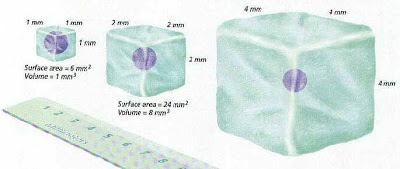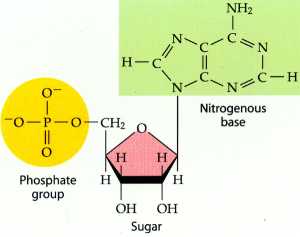Monday January 14th
Which Cell provides the most efficient surface-area to
volume ratio and WHY?
The smallest cell here would be the most efficient. WHY?? Because of the three cells shown here it has the HIGHEST surface area to volume ratio. Why is this important? The more surface area there is, the faster a cell can obtain nutrients and release waste. This is a KEY factor in cell size. (And why cells cannot just grow infinitely large)
Before a cell can divide what must the cell make a copy
of?
ALL of the chromosomes (in human cells that would be 46 chromosomes)
Draw out what a duplicated chromosome would look like
labeling the different parts. Then
describe how the two sides are related.
The chromatids are EXACT copies of each other (same exact DNA on each side)
Tuesday January 15th
DNA is made up of nucleotides. What are the three parts that make up a nucleotide?
Of these, which two make up the backbone? The Sugar (deoxyribose) and the phosphate group.
Which make up the “code” that writes our instructions?
The nucleotide bases
There are 4 different “codes” in DNA, what are they and
how do they pair up?
Adenine, Guanine, Cytosine, Thymine
A pairs with T
C Pairs with G
(G Created All Things)
During the Cell cycle – when is this DNA replicated?
The S phase (Synthesis Phase)
Wednesday January 16th
If given the following DNA Sequence, what would the
complementary strand look like?
GCCTAAGCG
CGGATTCGC
In EACH one of our cells, how many of these nucleotides
are there? (Recall from yesterday’s video) 6 BILLION
Thursday
January 17th
DNA replication is said to be semi-conservative. Once DNA replication is completed how are
the two resulting DNA molecules related to each other.
Each DNA molecule has one "original" or "Template" strand and one "new" Strand (See above how that works)
There are two “worker” molecules that perform DNA
replication. What are these two
molecules and what type of organic molecule are they? DNA Helicase which "unzips" the DNA and DNA Polymerase which adds new nucleotides (again, reference the image above) These are Enzymes which are a type of Protein
Tuesday January 22nd
In each of our cells, how many chromosomes are there? 46
These chromosomes are made up of both DNA AND Protein
Before a cell divides what MUST happen to the single
chromosomes? It must replicate (to form sister chromatids) - see picture below
Then the cell goes through a process known as Mitosis which is the division of which part of the cell? The nucleus








No comments:
Post a Comment